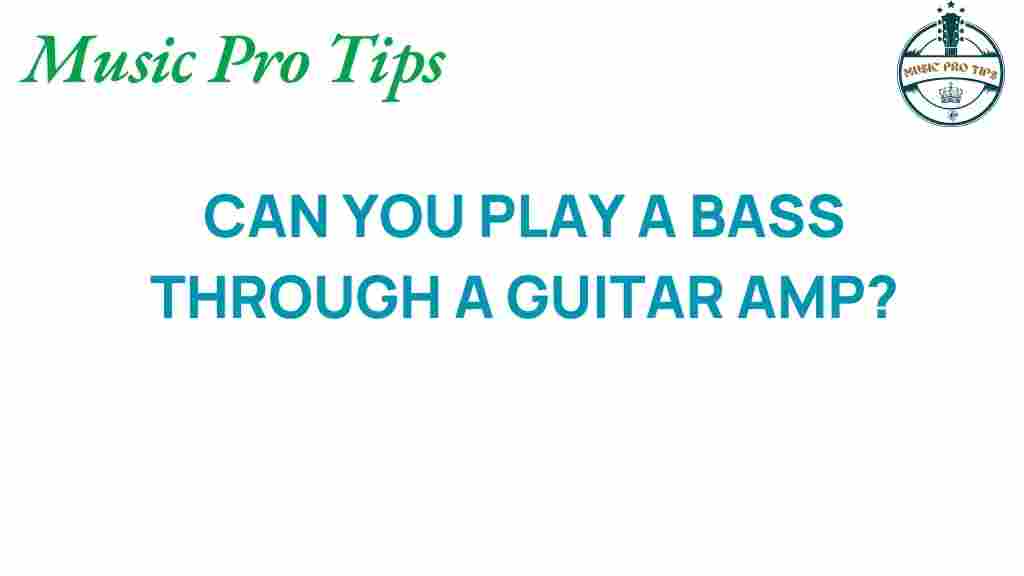Can You Really Play a Bass Through a Guitar Amp? The Surprising Truth
When it comes to music gear, one of the most common questions among musicians is whether you can play a bass guitar through a guitar amp. This inquiry often arises from the need for versatility and convenience in practice or recording sessions. In this article, we’ll explore the intricacies of using a guitar amp for bass guitar, focusing on sound quality, amplification, equipment compatibility, and more.
The Basics: Understanding Amplification
To understand if a bass guitar can be played through a guitar amp, we first need to delve into the basics of amplification. An amp’s primary purpose is to increase the audio signal’s power so that it can drive speakers and produce sound at a higher volume. However, different instruments produce different frequencies, which can affect how well they sound through various types of amplifiers.
The Difference Between Bass and Guitar Amps
Before diving deeper, it’s essential to recognize the key differences between bass amps and guitar amps:
- Frequency Range: Bass guitars typically operate at lower frequencies (40 Hz to 400 Hz), while guitar amps focus on higher frequencies (80 Hz to 1 kHz and beyond).
- Power Handling: Bass amps are designed to handle more power and produce a fuller sound, especially at lower volumes.
- Speaker Design: Bass speakers are larger and designed to move more air, accommodating the lower frequencies of a bass guitar.
Can You Play a Bass Guitar Through a Guitar Amp?
Yes, you can play a bass guitar through a guitar amp, but there are several factors to consider to ensure optimal sound quality and equipment compatibility.
1. Understanding Sound Quality
The sound quality you achieve when playing a bass guitar through a guitar amp will largely depend on the amp’s design and specifications. Here are some things to keep in mind:
- Tone: Guitar amps might not reproduce the deep tones of a bass guitar accurately. You could end up with a muddy or thin sound.
- Distortion: Guitar amps are often designed to handle overdrive and distortion, which can be less desirable for bass tones. Bass players typically prefer a clean sound with a full low end.
- Volume Levels: Exceeding the amp’s capacity can lead to speaker damage. Always be cautious about the volume when using a guitar amp for bass.
2. Equipment Compatibility
When considering using a guitar amp for a bass guitar, check the specifications of both your bass and the amp:
- Input Impedance: Ensure the input impedance of the amp is compatible with your bass guitar to avoid signal loss.
- Power Rating: Check the power rating of the guitar amp. A lower wattage amp may struggle to provide the necessary volume for a bass guitar.
3. The Step-by-Step Process
If you decide to use a guitar amp for your bass guitar, follow these steps to get started:
- Connect Your Bass: Use a standard 1/4-inch jack to connect your bass guitar to the guitar amp.
- Set the Volume Low: Start with the amp’s volume set low to prevent potential damage.
- Adjust EQ Settings: If your guitar amp has equalization settings, adjust them to enhance low frequencies. Consider boosting the bass and lowering the treble.
- Play and Test: Gradually increase the volume while playing your bass. Listen for any signs of distortion or undesirable sound quality.
Troubleshooting Tips
If you encounter issues while using a guitar amp for your bass guitar, consider the following troubleshooting tips:
- Check Connections: Ensure all connections are secure. Loose cables can cause unwanted noise or signal loss.
- Monitor Distortion: If you hear distortion at lower volumes, it may indicate that the amp isn’t suited for bass frequencies. In such cases, consider investing in a dedicated bass amp.
- Experiment with Settings: Adjust the EQ settings on your amp to see if you can achieve a more pleasing tone.
Audio Mixing Considerations
When mixing audio in a studio setting, using a guitar amp for bass may require additional considerations:
- Layering Sounds: If you layer bass tracks, consider using both a bass amp and a guitar amp for a unique tone.
- Post-Processing: Utilize audio mixing software to adjust the bass frequencies and enhance the overall sound quality. This can help compensate for any tonal deficiencies from using a guitar amp.
Conclusion: The Verdict
In conclusion, while it is indeed possible to play a bass guitar through a guitar amp, the results may not always be ideal. Musicians must consider sound quality, amplification characteristics, and equipment compatibility to achieve the best results. For serious bass players, investing in dedicated bass gear is usually the best route for optimal performance and sound.
Ultimately, your choice depends on your musical style and how much versatility you require from your equipment. Experimenting is key—don’t hesitate to try different setups and find what works best for your sound!
For more insights on music gear and equipment compatibility, check out this comprehensive guide. And if you’re interested in exploring more about mixing techniques, you can visit this resource for expert advice.
This article is in the category Equipment Compatibility and created by MusicProTips Team
